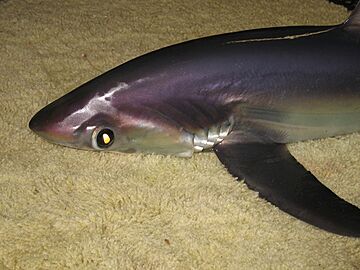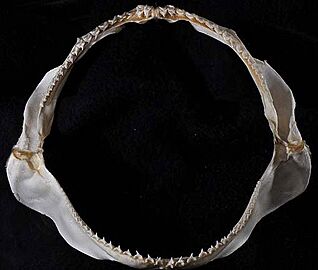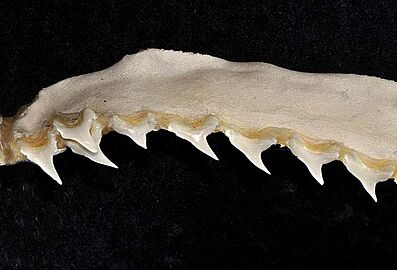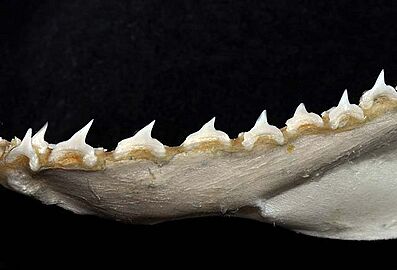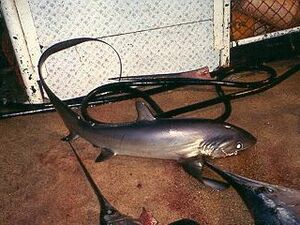Pelagic thresher facts for kids
Quick facts for kids Pelagic thresher |
|
|---|---|
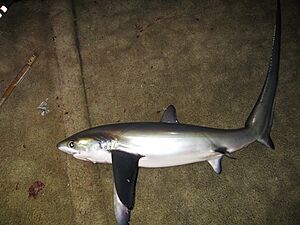 |
|
| Conservation status | |
| Scientific classification | |
| Genus: |
Alopias
|
| Species: |
pelagicus
|
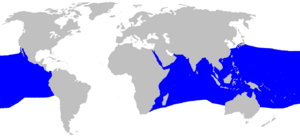 |
|
| Geographic range (blue) | |
The pelagic thresher (Alopias pelagicus) is a type of thresher shark. These sharks are known for their very long upper tail fins. The pelagic thresher lives in warm, tropical, and subtropical waters. You can find it in the Indian and Pacific Oceans. It usually stays far from shore. Sometimes, it comes closer to coastal areas.
People often mix up the pelagic thresher with the common thresher shark. But you can tell them apart! The pelagic thresher has dark coloring above its pectoral fins. The common thresher has white there. This shark is the smallest of the three thresher species. It usually grows to about 3 meters (10 feet) long.
Pelagic threshers mostly eat small fish that live in the middle of the ocean. They stun their prey by hitting them with their long tails. Like other mackerel sharks, the pelagic thresher gives birth to live young. Usually, two pups are born at a time. The baby sharks eat unfertilized eggs inside their mother. Young pelagic threshers are born quite large. People value these sharks for their meat, skin, and fins. They are caught by both commercial and sport fishers. In 2019, the International Union for Conservation of Nature said this species is endangered. This means it is at high risk of disappearing.
Contents
About the Pelagic Thresher Shark
The pelagic thresher shark was first described by a Japanese ichthyologist (fish scientist) named Hiroshi Nakamura. He wrote about it in 1935. The name pelagicus comes from a Greek word. It means "of the sea." Another common name for this shark is the smalltooth thresher. Scientists have studied its genes. They found that its closest relative is the bigeye thresher shark.
Where Pelagic Threshers Live
It can be hard to know exactly where pelagic threshers live. This is because they are often confused with common threshers. But we know they live across the Indo-Pacific region. They have been seen near South Africa and in the Red Sea. They also live off India, China, Japan, and Australia. You can find them near the Hawaiian Islands, California, and the Galapagos Islands.
These sharks mostly live in the open ocean. This means they are found from the surface down to at least 150 meters (492 feet) deep. Sometimes, they come closer to shore. This happens in places where the land slopes steeply into the ocean. They have been seen near coral reefs and underwater mountains. They can also enter large lagoons.
What Pelagic Threshers Look Like
The pelagic thresher is the smallest thresher shark. It is usually about 3 meters (10 feet) long. It weighs around 69.5 kg (153 pounds). The longest males can be 3.5 meters (11.5 feet). Females can reach 3.8 meters (12.5 feet). This shark has a body that is wide in the middle and tapers at the ends. Its upper tail fin is very long. It is almost as long as the rest of the shark's body.
Its pectoral fins are long and straight. They have broad, rounded tips. The first dorsal fin is in the middle of its back. It is about the same size as its pelvic fins. The second dorsal fin and the anal fin are very small.
The shark's head is narrow. It has a short, cone-shaped snout. Its eyes are very big when it is young. They get smaller as the shark grows older. The shark's teeth are very tiny. They are smooth-edged. The shark's skin is covered in small, smooth scales called dermal denticles.
The pelagic thresher is a deep dark blue on top. It is white underneath. The white color does not go above its pectoral fins. After the shark dies, its color quickly fades to gray. You can tell this shark apart from the common thresher by the dark color above its pectoral fins. Also, its pectoral fins have rounded tips.
Pelagic Thresher Behavior and Diet
The pelagic thresher is a very active and strong swimmer. It has even been seen jumping completely out of the water! Bigger fish, including other sharks, and toothed whales sometimes hunt pelagic threshers. This shark can get parasites like tapeworms and small copepods on its skin.
At Malapascua Island in the Philippines, pelagic threshers visit "cleaning stations." These are places where small cleaner wrasses (like Labroides dimidiatus) remove parasites from the sharks. The sharks act in special ways to let the cleaner fish do their job. They visit these stations most often in the early morning. This might be why these sharks, which usually live in the open ocean, are sometimes seen in shallow water.
What Pelagic Threshers Eat
We don't know a lot about what pelagic threshers eat. But their slender tail and small teeth suggest they eat small prey. Scientists have looked inside their stomachs. They found that these sharks mainly eat fish like barracudinas and escolars. These fish live in the middle depths of the ocean. This means pelagic threshers don't compete much for food with other big ocean hunters. Sharks like billfishes and tuna usually hunt closer to the surface.
Like other thresher sharks, the pelagic thresher might swim in circles. This helps them gather schooling fish into a tight group. Then, they hit the fish sharply with their long tails to stun them. Because of this behavior, pelagic threshers are often caught by their tails on longlines.
Life Cycle and Reproduction
Like other mackerel sharks, the pelagic thresher gives birth to live young. This is called ovoviviparity. It usually has two pups at a time, one in each uterus. There isn't a specific time of year for them to breed. Most adult females are pregnant all year round.
The baby sharks grow inside their mother. They are first fed by a yolk sac. Once they are about 12 cm (4.7 inches) long, they start eating unfertilized eggs. These eggs are produced by the mother. Each egg capsule is about 55 mm (2.2 inches) long. Young pelagic threshers are born very large. They can be up to 1.6 meters (5.2 feet) long. This is about 43% of their mother's length! Being born so big likely helps protect them from predators.
Pelagic threshers grow slower as they get older. Females become mature and can have babies when they are about 2.8–2.9 meters (9.2–9.5 feet) long. This happens when they are eight to nine years old. Males mature earlier, at seven to eight years old. They are about 2.7–2.8 meters (8.9–9.2 feet) long. The oldest known females have lived for 16 years. Males have lived for 14 years. Scientists think females might live for over 28 years. A single female can have about 40 young in her lifetime.
Body Temperature
Unlike some other sharks, the pelagic thresher is probably not "warm-bodied." This means it doesn't keep its body temperature warmer than the surrounding water. It doesn't have a special system of blood vessels that helps keep heat inside its body. However, it does have a system around its brain and eyes. This might help keep those important organs from getting too cold.
Pelagic Threshers and Humans
The pelagic thresher has never attacked humans. It has small jaws and teeth for its size. It also tends to swim away from divers.
Commercial fishing boats catch this shark in the central Pacific and western Indian Oceans. They also catch them off California and Mexico. Off northeastern Taiwan, these sharks make up a big part of the annual shark catch. The meat is sold for people to eat. Their skin is used to make leather. Their fins are used for shark fin soup in Asia. The oil from their liver can be used in cosmetics, health foods, and machine oil.
Pelagic threshers are also popular with sport fishers. The International Game Fish Association lists them as a game fish. The biggest ones caught have been in New Zealand.
These sharks are often caught by accident. This is called bycatch. They get caught in longlines and driftnets meant for other fish like tuna. They are also sometimes caught in gillnets and antishark nets.
Images for kids



